Austin Lease Trends
March 30,2025: The Austin-area rental market has experienced significant fluctuations over the past decade, with the number of active lease listings showing both periods of contraction and rapid expansion. From 2015 to 2025, the availability of rental properties has grown substantially, with notable shifts occurring between 2020 and 2025. This data highlights key trends in lease inventory, revealing insights into the evolving dynamics of Austin’s rental housing market.
In 2015, the average number of active lease listings across the Austin-area MLS stood at approximately 2,400. By 2024, this number had more than doubled to 6,128, reflecting a significant increase in available rental properties. The median number of listings followed a similar trajectory, rising from 2,376 in 2015 to 6,345 in 2024. This upward trend suggests an increasing supply of rental homes, which could be influenced by new construction, shifting migration patterns, and broader economic factors.
The most dramatic increase in lease listings occurred between 2020 and 2025. In January 2021, there were 2,380 active rental listings, but by January 2025, the number had surged to 5,728. This represents a 140.7% increase over four years. The highest number of active listings was recorded in July 2024, when the market peaked at 7,133 available rentals. March 2025 reported 4,919 listings, showing a decline from the mid-2024 peak but still maintaining elevated levels compared to historical averages.
Year-over-year percentage changes indicate substantial volatility in lease availability. From 2016 to 2025, the January lease inventory grew by 162.3%, while February saw an increase of 159.3%. In the most recent five-year period (2021 to 2025), January listings increased by 118.4%. Certain months experienced extreme shifts, such as March 2021, which saw a 30.9% decline, followed by a rebound in March 2023 with a 77.3% increase. These fluctuations highlight the changing supply-demand dynamics in the rental market, potentially driven by economic conditions, employment shifts, and population growth.
The data also reveals a key shift in 2020-2021, where rental availability temporarily contracted. Some months in 2021 saw a nearly 40% decline in active listings compared to previous years. However, from 2022 onward, the market reversed course, with lease inventory increasing dramatically through 2025. This could indicate a post-pandemic correction, an influx of new rental properties, or changing homeownership affordability.
As the Austin rental market continues to evolve, the surge in lease listings suggests a competitive environment for landlords and property managers. Higher inventory levels may lead to adjustments in rental pricing and leasing strategies as the market works to balance supply with demand. Understanding these trends is crucial for real estate professionals, investors, and tenants navigating the ever-changing landscape of Austin’s housing market.




